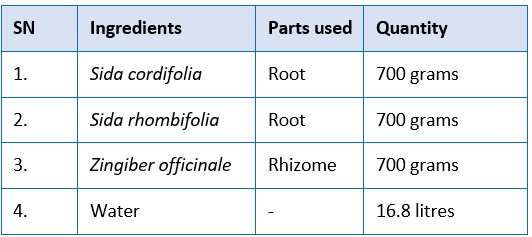Pharmaceutical analytical study of Baladi Kwatha and to evaluate the effect of various concentration of preservatives in it
DOI:
https://doi.org/10.21760/jaims.9.1.9Keywords:
Baladi Kwatha, Panchavidha Kashaya Kalpana, Shelf life, Preservatives, AyurvedaAbstract
Due to advent of commercialization longer shelf-life becomes the need of the hour for various pharmaceutical products, especially for the preparation of Kwatha Kalpana (Decoction). The shelf-life of Kwatha is 1 Prahara (3 hours). According to Acharya Sharangadhara it is considered as Sadhyo-sevana. Panchavidha Kashaya Kalpana are considered as basic pharmaceutical preparation and the most important form of Kalpana. But the preparation of Kwatha is not possible all the times as the shelf life of Kwatha is short and makes it impossible to market it as soon as it is prepared. Therefore, there is need to find different ways to preserve the Kwatha for longer duration for their easier usage and transportation. This present study is carried out mainly in 3 stages, that is, pharmaceutical study, analytical study and microbiological study. In pharmaceutical study, the preparation of Baladi Kwatha was carried out as per the classical reference of Shamana Kashaya and they were added with different ratios of preservatives (SB-0.1%, SB-0.2%, SB-0.2% + MP-0.05% + PP-0.05%, SB-0.48% + MP-0.1% + PP-0.1%). No much changes were noted in analytical studies. Preservatives like, sodium benzoate, in permitted amounts could only preserve acidic Kwatha for a shorter period. Hence, marketing Baladi Kwatha with sodium benzoate cannot be properly stabilized by 0.1% & was observed that at least 0.2% is required to preserve the Kwatha for 60 days free from microbial contamination. It was observed that as per the permissible limit, the preservatives when used in combination of sodium benzoate 0.2%, methyl paraben 0.05%, propyl paraben 0.05%, has passed the shelf-life for 3 months.
Downloads
References
Agnivesha, Charaka samhitha revised by Charaka and Dhridabala with Ayurveda Deepika commentary of Chakrapanidatta, edited by Jadavji Trikamji Acharya, Published by Chaukambha Orientalia 2009, Varanasi, Sutrasthan 4/7, Pp: 738, p:31
Vriddajivaka, Kashyapa Samhitha, preached by Maharshi Maricha Kashyapa, commented and translated by P.V Tewari, Published by Chaukambha Vishwabharati Edition 1, 2002, Khila sthana Pp 792, p:454
Agnivesha, Charaka samhitha revised by Charaka and Dhridabala with Ayurveda Deepika commentary of Chakrapanidatta, edited by Jadavji Trikamji Acharya, Published by Chaukambha Orientalia 2009, Varanasi, Sutrasthan 4/7, Pp: 738, p:31
Yogaratnakara, Indradev Tripathi, Krishnadas Academy, Varanasi, first edition, 1998, Pp:894 p:158
Sharangadhara, Sharangadhara samhitha with the commentaries of Adhamalla Deepika and krishnaram Gudartha Deepika, Parashuram Shastry Vidyasagar, Choukambha publication, Varanasi, Seventh edition, 2008, Pp: 398, p:145
Haritha, Haritha samhitha with Nirmala Hindi Commentary, Vaidya Jayamini Pandey Chaukambha Vishwabharati, Varanasi, 1st edition, Pp:544, p:187
K. Nishteswar, R Vidyanath, Sahasrayogam with English translation, Chowkambha Sanskrit series office, Varanasi Kashaya Prakarana, Vatahara kashaya Pp:540 p:43
William C. Frazier Dennis C. Westhoff, Food Microbiology, Tata M. Graw-Hill Publishing company Ltd. Fourth edition, Pp:539, p:148















